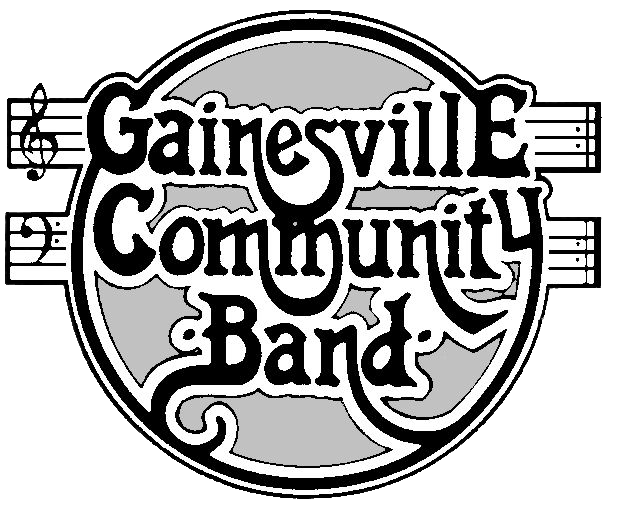Spring 2010: Mothers Day Concert
We dedicate this concert to mothers everywhere, and we look forward to welcoming all mothers who attend as our special guests. There is no charge for admission.
Our setting will be the Fellowship Hall of Trinity United Methodist Church, 4000 N W 53rd Avenue in Gainesville. This is a great venue for playing (and listening to!) a concert. The acoustics are wonderful, and there is ample seating and parking.
Dr. Gerald Poe, music director for the Gainesville Community Band, has put together an exciting program, including a solo performance by Joseph Hughes, GCB’s principal euphonium. The list of compositions scheduled for the concert includes the following:
The Nutmeggers, by Eric Osterling.
The Nutmeggers was the first of several popular marches by Osterling to be published and to catch the fancy of bandsmen and their audiences. All have a unique, lively, and cheerful sound. The title for this march came from one of the two nicknames of Osterling’s home state, Connecticut. The early Connecticut traders were said to have sold wooden nutmegs for real ones. Osterling is a composer, arranger, music educator, and ASCAP award-winning writer, and his teaching career included, among other settings, six years on the faculty at Florida Southern College.
Velocity, by Robert Sheldon.
Velocity, Sheldon’s opus 137, was commissioned by the Alexander W. Dreyfoos, Jr., School of the Arts Wind Ensemble in West Palm Beach, Florida. It is described by the publisher, Alfred Music Publishing, as follows: “’Velocity’ is defined in physics as the rate of change of position. This brief musical essay seeks to portray velocity in all of its forms—breathtaking speed to brutal force, the flowing elegance of flight to the heart-pounding thrill of a reckless drive. Full of rhythmic intensity, Doppler effects and technical flair, Velocity takes you on a musical ride you won’t soon forget.
Dances Americanesque, by William Owens.
Three dances are musically interpreted in this fanciful multi-movement work. The lively Promenade opens with a fanfare-like statement and a tempo setting that instructs the band to play “Gallantly.†The Waltz begins with a flute solo, then goes through different moods, from carefree to mysterious and back. The work concludes with the hard-driving Galop, a fast, furious and exhilarating finale. William Owens teaches instrumental music in the Everman (Texas) Independent School District and is a member of the summer music faculty at Villanova University. He is very active as a composer, clinician and conductor throughout the United States and Canada.
â€Western One-Step†and “Wallflower Waltz†from Suite of Old American Dances, by Robert Russell Bennett.
This 1950 composition recreates the mood of a hoedown and features popular dances from the composer’s youth. The GCB performs two dances from the Suite: “Western One-Step,†a variation of an early ballroom dance that was a precursor to the foxtrot, and “Wallflower Waltz,†a beautiful dance that charms with its familiar 1-2-3 meter. Bennett wrote extensively for concert band but is perhaps best known as orchestrator and arranger for Broadway shows and films, including Porgy and Bess, The Sound of Music, Show Boat, Camelot, and numerous others.
Bayou Breakdown, by Brant Karrick.
Starting with a four-part fugue scored for woodwinds, this work next moves to a folk song-like lyrical theme, then eventually back to the initial fugue. Dr. Karrick, who is director of bands at Northern Kentucky University, said he had been influenced by bluegrass music and wrote, “These wonderful sounds along with the live Cajun music I enjoyed listening to while living in Baton Rouge . . . served as the musical inspiration for Bayou Breakdown.â€
All Those Endearing Young Charms, by Simone Mantia, arr. Harold Brasch.
The origin of this beautiful traditional air has been claimed by England, Scotland and Ireland. Simone Mantia, a pioneer of the American euphonium style, set the melody into a theme and variations piece. The late Harold Brasch, former euphonium soloist with the U.S. Navy Band, wrote this arrangement, which has become one of the major works of the original euphonium repertoire.
Our soloist is Joseph Hughes, principal euphonium with the GCB. Mr. Hughes is a graduate of Louisiana State University and Florida State University and is director of bands at Eastside High School.
Latin & Lace, by John F. Edmunds.
A play on the phrase, “Satin and Lace,†the title of this piece reflects the composition’s mixture of . . . Latin and lace. Mr. Edmunds, recently retired professor of music at Louisiana State University, is credited with more than 100 publications for band, and a regular recipient of ASCAP special awards. He holds degrees from Florida State University and the University of Florida and currently lives in Sugarmill Woods, Citrus County, Florida.
Tree City Fanfare, by Richard W. Bowles
Richard W. Bowles (1918-2009), nationally recognized band director and composer, joined the University of Florida faculty in 1958 as director of the Gator Marching Band and professor of trombone. In 1961 he was appointed Director of Bands. In addition to the hundreds of compositions and arrangements he wrote for the university bands, he had over 400 published works of music. Upon his retirement from the university in 1985 he became a special friend of the Gainesville Community Band, serving as guest conductor of the band on many occasions. He composed this, the band’s signature piece, in 2003 and dedicated it to the citizens of Gainesville.



Comments are closed.